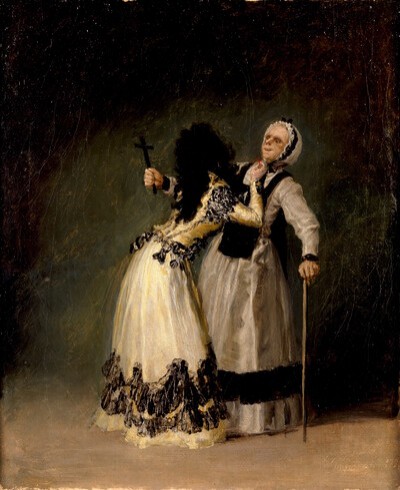- Cronología
- 1795
- Dimensiones
- 30 x 25 cm
- Técnica y soporte
- Oil on canvas
- Reconocimiento de la autoría de Goya
- Documented work
- Titular
- Private collection
- Ficha: realización/revisión
- 21 Jun 2010 / 13 Jun 2023
- Otros títulos:
-
“The Sanctimonious”, with the Child Luis Berganza and the Little Black Girl María de la Luz
“The Sanctimonious”, with the Child Luis Berganza and the Little Black Girl María de la Luz
Luis Berganza año 1795 ("Luis Berganza, 1795", lower right-hand corner).
Luis Berganza, son of Tomás Berganza, the Duchess of Alba's administrator and one of the inheritors in her will, became the new owner of this canvas and its companion piece, The Duchess of Alba and "the Sanctimonious".
This work, which forms a pair with The Duchess of Alba and "the Sanctimonious", gives a glimpse into everyday life at the Palace of Buenavista in Madrid. Here we see the Duchess of Alba's maid, Rafaela Luisa Velázquez, made into the unwilling object of a game played by two children, who are pulling at her skirt. She is forced to hold on to a fourth person, of whom only an arm is visible, to stop herself from falling over. The two children could be Luis de Berganza, the son of the palace's administrator, and a little black girl who is also known to have lived there.
To paint these two scenes, Goya was given access to the private sections of the Palace of Buenavista, just as he tells us in a letter he wrote to his friend Martín Zapater in 1794, now in the Prado Museum, in which he says: "You had better come to help me paint the [Duchess] of Alba, who barged into the studio yesterday to have her face painted by me, and she got her way; I certainly prefer this to painting on canvas, and I will also have to paint her full-length...".
The figures are arranged in front of a neutral, ochre-coloured background, to which they are connected only by their shadows. This device, which had already been employed by Diego Velázquez (Seville, 1599-Madrid, 1660) in Pablo de Valladolid (1633, Prado Museum, Madrid), was later to be used by Édouard Manet (Paris, 1832-Paris, 1883) in The Fifer (1866, Musée d'Orsay, Paris).
-
Goya. El Capricho y la Invención. Cuadros de gabinete, bocetos y miniaturasMuseo Nacional del PradoMadrid1993from November 18th 1993 to February 15th 1994. Exhibited also at the Royal Academy of Arts, London, March 18th to June 12th 1994 and The Art Institute of Chicago, Chicago, July 16th to October 16th 1994, consultant editors Manuela B. Mena Marqués and Juliet Wilson-Bareaucat. 65
-
Goya. La imagen de la mujerMuseo Nacional del PradoMadrid2001from October 30th 2001 to February 10th 2002. Exhibitied also at the National Gallery of Art, Washington, March 10th to June 2nd 2002, consultant editor Francisco Calvo Serrallercat. 34
-
Goya: Prophet der ModerneAlte NationalgalerieBerlin2005from July 13th to October 3th 2005. Exhibitied also at the Kunsthistorischemuseum, Vienna, October 18th 2005 to January 8th 2006, consultant editor Manuela B. Mena Marquéscat. 37
-
De Luca Giordano a Goya. Pintura del siglo XVIII en EspañaFundación Francisco GodiaBarcelona2010From November 11th 2010 to January 31st 2011cat. 17
-
La Duquesa de Alba y Goya. Estudio biográfico y artísticoMadridBlass1928p. 191
-
L'œuvre peint de Goya. 4 volsParís1928-1950p. 216, cat. 181
-
Vie et ouvre de Francisco de GoyaParísOffice du livre1970p. 171, cat. 353
-
BarcelonaPolígrafa1970vol. I, p. 298 cat. 367
-
Goya. El capricho y la invención. Cuadros de gabinete, bocetos y miniaturasMadridMuseo del Prado1993pp. 260, 261 y 263 (il.)
-
Goya. 250 AniversarioMadridMuseo del Prado1996cat. 86
-
Cartas a Martín ZapaterMadridIstmo2003p. 344, nº 138
-
Goya, la imagen de la mujerMadridMuseo Nacional del Prado y Fundación Amigos del Museo del Prado2001pp. 186 y 187 (il.), cat. 34
-
De Luca Girodano a Goya. Pintura del siglo XVIII en EspañaBarcelonaFundación Godia2011pp. 84-89

